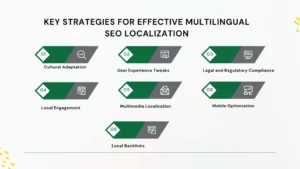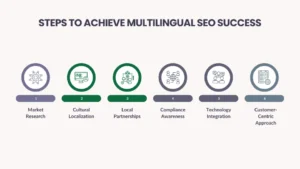The Emergence of Multilingual SEO Strategies
Multilingual SEO stands as an essential strategy for businesses aiming to expand into global markets. Multilingual SEO is not about translating content into various languages but about optimizing website content to resonate with the cultural nuances of the target audience and customers’ search behaviors of different regions. Multilingual SEO ensures that a website is accessible, relevant and engaging for users on a global level, regardless of their language.
The Advantages of Multilingual SEO
Multilingual SEO is a powerful tool for businesses looking to reach international customers. It’s not just about translating content—it’s about adapting it to fit different cultures and search habits. By speaking your customers’ language, you can:
- Expand your reach and tap into markets.
- Boost engagement as users are more likely to stay and buy from a site in their own language.
- Improve website rankings by providing a better user experience.
This is how to achieve multilingual SEO:
- User-Friendly Experience: Offer content, customer service, and checkout in multiple languages to increase trust and sales.
- Local Keywords: Use people’s actual keywords and terms that they actually search for in each region.
- Cultural Adaptation: Adjust content to fit local preferences, not just words.
- Local Backlinks: Get links from trusted websites in your target language to improve credibility.
- Technical SEO: Use
hreflangtags to tell search engines which language version of a page to show. This avoids duplicate content issues. - Social media: Engage users on platforms they prefer.
- Track & Improve: Monitor performance and insights in each language and adjust based on data.
Why Localization Matters in Multilingual SEO for Global Success
In SEO, content localization is about adapting your message to fit different cultures, behaviors, and search habits to ensure your content feels natural and relevant to users worldwide:
- For Better Engagement: People engage with content that feels made for them, not just translated.
- Higher Website Rankings: Search engines reward websites that match local search intent.
- Stronger Audience Trust: Showing cultural understanding builds credibility in new markets.
Key Strategies for Effective Multilingual SEO Localization
 Cultural Adaptation
Cultural Adaptation
Adjust content to fit local customs, humor, and values.
User Experience Tweaks
Change colors, layouts, or images to match local preferences.
Legal and Regulatory Compliance
Follow local rules for ads, privacy policies, and product claims to avoid any rejection by the authorities.
Local Engagement
Encourage reviews, comments, and shares from local users.
Multimedia Localization
Adapt images, videos, and examples to be region-specific, using characters that present the local context.
Mobile Optimization
Ensure fast load times and easy navigation—many global users browse on phones.
Local Backlinks
Get links from trusted local websites to improve rankings.
Challenges and Opportunities in Multilingual SEO
Multilingual business expansion comes with a unique set of challenges and opportunities for global strategists. These challenges include understanding regional regulations and ensuring messaging is contextually appropriate in each market. Culturally aligned brands enhance customer trust and loyalty, driving long-term growth. The challenge lies in launching a culturally nuanced campaign that balances the global brand identity with local relevance to maximize engagement.
Steps to Achieve Success

- Market Research: Analyze the regional demand and competition data on consumer behavior and local trends. This can reveal high-potential markets.
- Cultural Localization: Adapt products and messaging to align with local values to ensure deeper market penetration.
- Local Partnerships: Collaborate with regional distributors or influencers to accelerate market entry.
- Compliance Awareness: Stay informed—different regions have varying legal requirements to prevent costly regulatory missteps.
- Technology Integration: Multilingual CRM systems and AI-driven localization tools streamline cross-border operations.
- Customer-Centric Approach: Prioritize user experience in each market to foster organic growth through word-of-mouth and repeat business.
Get Help
Check our multilingual SEO services and contact us for further details.









